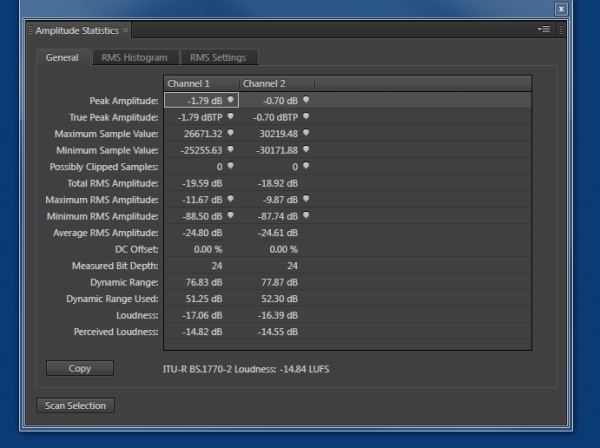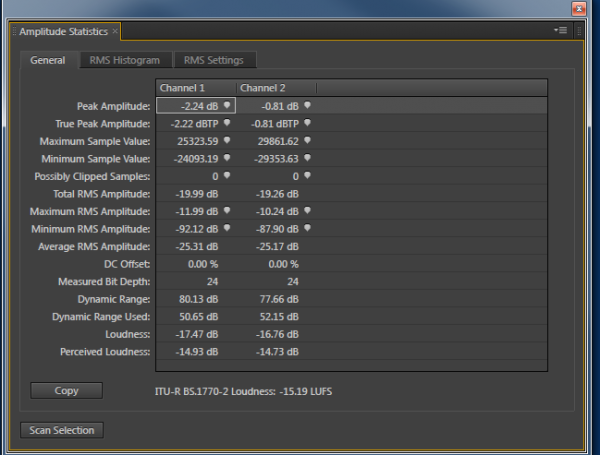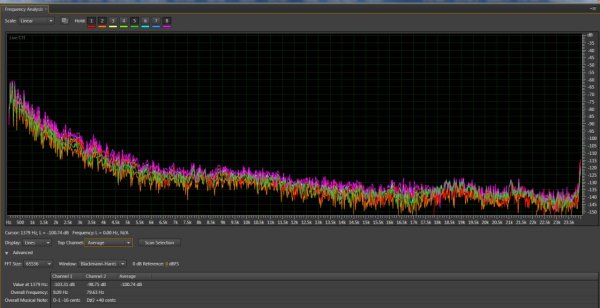I've deliberately kept out of this discussion for a while because apart from being sick and tired of the terms "kitty litter" and placebo" being continually bandied about over and over again, it has inevitably trended towards objective measurement which in my opinion is fraught with too many caveats - at least outside of professional measuring laboratories using exceptionally expensive equipment. I subscribe to a couple of British audio monthly magazines and I love their equipment reviews because they both listen and measure. As distinctly opposed to measuring and not listening (let alone owning on a daily basis). Or listening and not measuring as is the case with me. But my excuse for not measuring is that I do not have formal tertiary qualifications in scientific measurement and I certainly don't own the incredibly expensive analytical equipment needed to make those measurements (unlike HiFi World and HiFi News and Record reviews where the people who do the measuring are highly respected world-wide, have the right equipment, experience and knowledge and produce consistent comparative results.
Even then, I only look at measurements out of interest and to see (if I have heard or own the component) if any of the measurements correlate to what I hear. Often they do but sometimes they don't. Just as an example, I don't find direct correlations between jitter numbers and subjective sound, though I definitely prefer in general the sound of components that exhibit low jitter (please let's not go there - I am just using that as an example of where I don't hear a correlation between measurements and what I hear). I also tend to wonder (as do some well-known - even famous - living engineers) whether we are still missing something (or some things) when we do measure.
But I want to address this noise "issue". Those two original test files were sourced from a 45 RPM LP that was itself remastered from a 1962 (so pre-Dolby A, tubed, fully analogue) recording on a 1/4 inch tape at 15 inches per second (probably made on a Studer but I am not sure). So the source material is going to have a lot of "analogue noise" to begin with. There is the noise from the original tape, the remastering chain and the LP itself. The two files were made on the 5th and 6th play of that particular LP. I am not sure which particular section those FFT spectrograms were derived from, but I do have to wonder how one is supposed to distinguish between the music content and the noise content. And even if it can distinguish between the two, what noise simply comes from the "analogue" side of things and how much comes from the "digital" side of things. It might be possible, for example, that "more noise" might not be "bad" because more noise could just as easily mean the defects in the original analogue chain were more faithfully captured with the Entreq connected than with it disconnected. Or it might not be of any consequence at all.
With that in mind (and because I was asked earlier but did not oblige), I have actually decided to go to the trouble of recording "silence" on the analogue input of the workstation, both with and without the Entreq connected. I have done these over the last 24 hours so the box had a full day sitting back in the system when the test was made. Since I am using a 10 second sample from each method, I did these at 24/96 instead of 24/48 as was the case earlier. That way, it is possible to get a better analysis of the noise spectrums and statistics (not that I honestly think they really mean much).
Now the only reason I went to the trouble of doing this and am posting the files/ results is that I don't what incorrect conclusions to be made from any measurements people decide to make. If we left it like it was, people might think the Entreq adds noise and is therefore "bad". However the test I have made over the last day show that it does not add any noise at all. Infact if you really want to be incredibly pedantic about it, the noise floor spectrogram was very slightly lower with the box connected (actually it was interestingly by the same amount that the music recording is lower in level by), but arguably not enough (in my opinion) to make it either statistically or musically (audibly) meaningful. I could have boasted that wow, the noise floor with the Entreq has an absolute peak more than -0.5 dB quieter in both left and right channels, but I honestly do not think such tiny changes at such low levels (we are talking over -100 dBA here) would in any way begin to even remotely account of the differences in sound I (and others as this thread demonstrates) hear when the boxes are used (or for those without he boxes, the differences in the actual music content between the two files).
Nevertheless, in the name of transparency, here are the results of testing "silence" at the analogue input with the recording gain fader set to maximum. So you are basically looking at the analogue noise floor of my recording system (yes, it is not in the professional league and I never claimed it was). So if you think back to those two sample recordings, they would have been recorded "over" (or in addition to) the noise floors / spectrograms you see below. The spectrograms cover the level range -120 dBFS to -150 dBFS and DC to 48,000 KHz.
1. Statistics without the Entreq box connected:
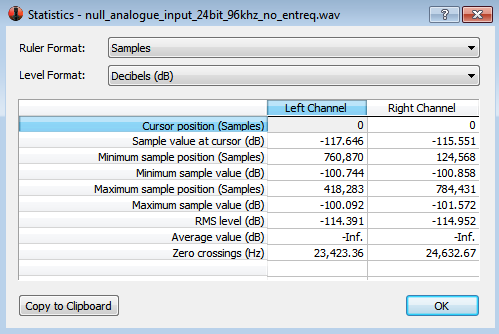
2. Statistics with Entreq box connected:
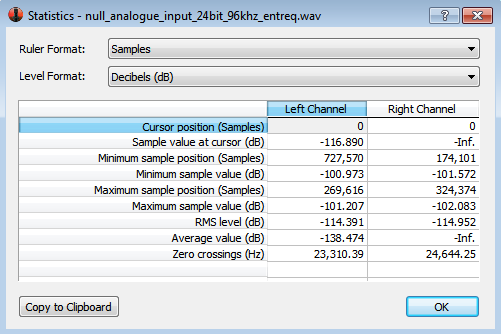
3. Spectrogram without the Entreq box connected:
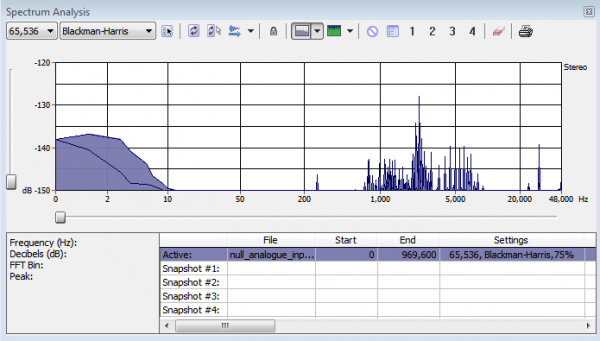
4. Spectrogram with Entreq box connected:
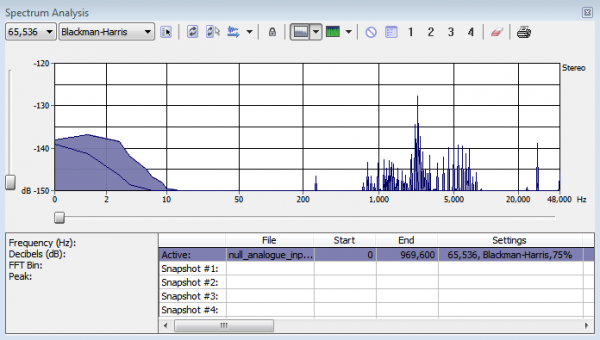
In my opinion there is no appreciable difference that accounts for the difference in sound if we are just analysing noise floors. The "improvement" if you can even call it that with the box connected is arguably insignificant.
As for the difference in the levels, yes, I did notice that. I could have "cheated" and raised the level about 0.3 or 0.4 dB (but then that would have made the loudest peak higher on the Entreq recording than on the recording without it). But I wanted to make sure that each file was made using precisely the same process and that the
only variable was the box (OK, and yes, the 5th and 6th play of the LP). As for the difference, even if you do increase the levels to look "the same", the two files still sound different and the one with the box connected sounds better (at least to me and it sounds closer to the original analogue feed as well). I am well aware of how differences in level can result in a bias one way or another but in this case the files still sound different no matter what you try to do with them.
I might opine that the level differences may even equate to the reduced noise levels I noted in the "silent" recordings referred to above (since the differences in level are actually almost identical) but again, since I am not a measurement person per se, I prefer not to speculate.
My main reason as I say for making this post is to dispel the notion that the box adds noise or in whatever way makes the sound worse as opposed to better. At least in my own experience, if a recording is "noisier" with the Entreq box connected, that is more likely a superior rendition of the flaws (whatever they may be) inherent in the original source material. Unfortunately my setup is only geared to make analogue transcriptions so I am unable to feed it with a perfect pure sine tone into the analogue input for example. I honestly think in the end if these boxes are to be measured, it is beyond the scope of general internet and really needs to be done under professional laboratory conditions with appropriate equipment. Even then, I still remain suspicious that measurement circa 2016 does not tell the whole story about audio. If it did, what I hear and measurements should really correspond with each other, but they don't. That is why I keep out of measurement forums and do not frequent those particular audio sites where members do not listen and only measure!
Link to "silence" files:
https://www.sendspace.com/file/gxxbk9